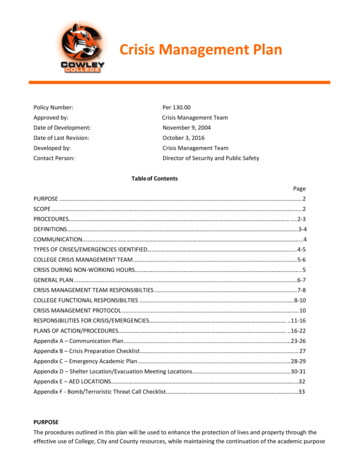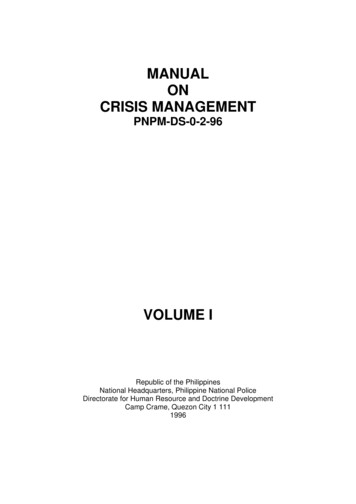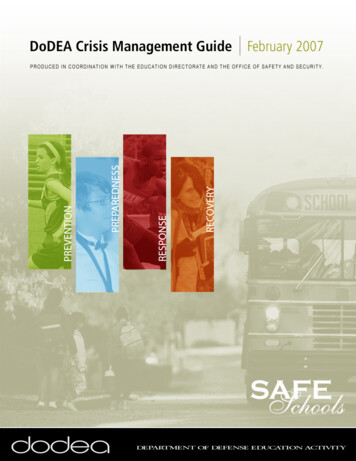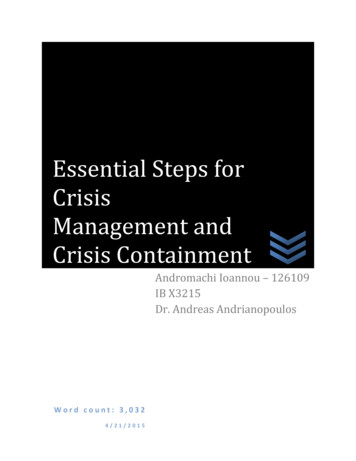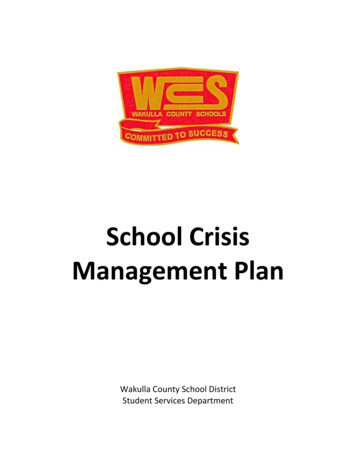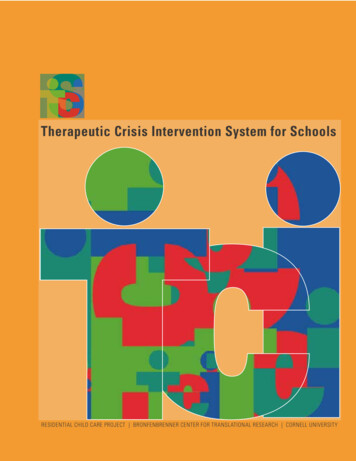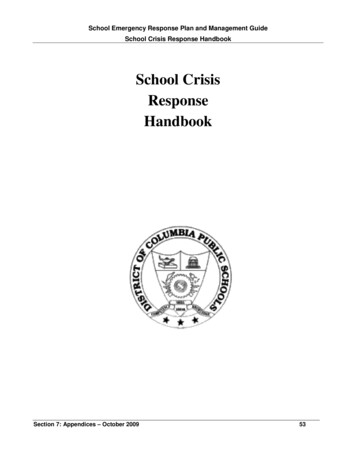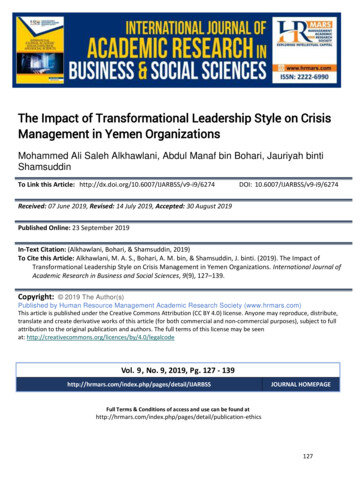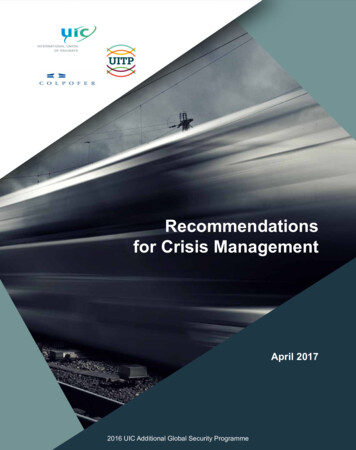
Transcription
Recommendationsfor Crisis ManagementApril 20172016 UIC Additional Global Security Programme
Recommendations for Crisis ManagementDefinitions and AcronymsCrisisA crisis is a sudden eventor set of circumstances thatcould significantly affect anorganization’s ability to carry outits business, that damages anorganization’s reputation and/orthreatens the environment, thehealth, safety, and well-being ofemployees, customers, or thepublic at large. If not handled in anappropriate and timely manner (orif not handled at all), a crisis mayturn into a disaster or catastrophe.Crises are deemed to be negativechanges in the security, economic,political, societal, or environmentalaffairs, especially when they occurabruptly, with little or no warning.Recommendations for Crisis ManagementCoordinator: Jochen GrimmeltEditor: Security Division, security@uic.orgLayout and production: Marina Grzanka, graphic designer, marina.grzanka@gmail.comISBN: 978-2-7461-2602-2Warning: No part of this publication may be copied, reproduced or distributed by any means whatsoever, including electronic,except for private and individual use, without the express permission of the International Union of Railways (UIC). The sameapplies for translation, adaptation or transformation, arrangement or reproduction by any method or procedure whatsoever.The sole exceptions – noting the author’s name and the source – are analyses and brief quotations justified by the critical,argumentative, educational, scientific or informative nature of the publication into which they are incorporated (Articles L 122-4and L122-5 of the French Intellectual Property Code). International Union of Railways (UIC)Paris, April 2017List ofabbreviationsCrisisManagementCrisis Management (CM) isthe overall coordination of anorganization’s response to a crisis,in an effective, timely manner, withthe goal of avoiding or minimizingdamage to the organization'sprofitability, reputation, or abilityto operate and often involves theneed to make quick decisionson the basis of uncertain orincomplete information.CM includes the developmentof plans, based upon an integralapproachwithinternalandexternal organizations, to reducethe risk of a crisis occurring andto deal with any crises that doarise, and the implementation ofthese plans so as to minimize theimpact of crises and assist theorganization to recover from themand restart its normal activities asquickly as possible.CM: Crisis ManagementCMT: Crisis Management TeamHR: Human ResourcesCEO: Chief Executive OfficerBU: Business UnitCSO: Chief Security Officer3
Recommendations for Crisis ManagementRecommendations for Crisis ManagementContentsDEFINITIONS AND ACRONYMS 31. INTRODUCTION 62. METHOD 83. CRISIS MANAGEMENT PLAN 4 CONCLUSION 345 OUTLOOK 346 ANNEX 353535373.1 Risk Analysis 3.2 Priorities in Crisis Management 3.3 Structure and Content of a Crisis Management Plan 3.4 Alert Levels 3.5 Composition of the Crisis Management Team 3.5.1 Central Crisis Management Team 3.5.2 Extended Crisis Management Team 3.5.3 Regional, Local or Business-Related Crisis Teams 3.5.4 Working Groups 3.5.5 Endurance 3.6 Crisis Management Infrastructure 3.7 Crisis Communication 3.7.1 Incident and Situation Reporting 3.7.2 Exemplary Information Matrix – Communication Priorities 3.7.3 Information Policy and Requirements 3.7.4 Codewords 3.7.5 Terminology 3.7.6 Public Communication 3.8 Training 3.8.1 Communication/Alert Exercises 3.8.2 Tabletop Exercises 3.8.3 Command Post Exercises 3.8.4 Full (Live) Exercise 3.9 Cooperation 3.10 Evaluating and Updating your Crisis Management Plan 6.1 Checklists 6.1.1 Crisis Management Team – Meeting Agenda 6.1.2 Crisis Management Team – Meeting Minutes 45
Recommendations for Crisis ManagementRecommendations for Crisis Management1. IntroductionDuring the 11th Security Congress in New Delhi, UIC was asked by its members to provide abenchmark study about the Crisis Management efforts within the railway community.VIA Rail CanadaNorwegian National RailThis request was embedded in an additional security program1 and was completed from March2016 to October 2016, in cooperation with UIC and its members. During a workshop on CrisisManagement that took place during the Security Week, hosted by UIC from 21.06.2016 to24.06.2016, UIC was asked by its members to provide additional recommendations for CrisisManagement efforts and requirements.The results and the required documentation were ready by October 2016 and introducedduring the Security Congress in Helsinki.TrafikverketSJ ABJSC RZD / FPCJSC NC Kazakhstan temir zholyTUNISIAN NATIONAL RAILWAYEast Japan Railway CompanyONCFWest Japan Railway CompanyUIC thanks all members who participated in the Study, in the interviews and review, and whocontributed to the completion.Israel RailwaysIndian RailwaysDeutsche BahnAdditionally, we would like to thank COLPOFER and UITP for participating and co-authoringthis SVASCOS S.A.LATVIAN RAILWAYJSC “LITHUANIAN RAILWAYS”PKP IntercityÖBBZSSK / ZSSK CargoGraz-Köflacher Bahnund Busbetrieb GmbHRenfe-OperadoraHŽ CARGO d.o.o.Comboios de PortugalAdministrador de InfraestructurasFerroviariasSLOVENSKE ŽELEZNICE, d.o.o.TCCD¹ Together with a) information exchange on international trains and b) training of security and non-securitystaff67
Recommendations for Crisis ManagementRecommendations for Crisis Management2. Method3. Crisis Management PlanTransport operators must be aware that “if you operate – things will happen”. So better beprepared.A Crisis Management Plan should be considered as a superordinated document with underlyingemergency plans. It provides overall organizational and general procedural guidelines for themanagement of information, activities, operations, and communications during an escalatingemergency. It is the basis for the decision-making process of the rail operator.The following Chapters should assist rail operators in developing a Crisis Management Plan,or to check their existing plans for completeness. These recommendations are based on the questionnaires provided by the members, additional interviews with selected members, information and material on Crisis Management efforts provided by members, literature and internet research on good practices and the state of the art and the review of these recommendations by selected members.In consideration of the close interaction and the multiple interfaces between rail operators,infrastructure operators, public transport operators, and police authorities, UITP and Colpoferwere also invited to review and co-author the document, rendering it into a guideline for alltypes of operators.Accordingly, within this document, the term “Operators” encompasses all types of rail,infrastructure and public-transport operators, represented by UIC, Colpofer, and UITP.This is not intended as just another document about Crisis Management, but as a practicalapproach, giving rail operators as much concrete and practical advice as possible. Therecommendations take into account the different sizes and abilities of rail operators, aiming ata level that should be considered as the minimum efforts.3.1 Risk AnalysisThe development of a Crisis Management Plan should start with an assessment of thepotential vulnerabilities, risks, and threats facing a rail operator and the evaluation of the crisispreparedness at the corporate, regional or local level.At least, the risks of incidents arising from: operations (accidents, collisions, derailments, fire, dangerous goods spillage), the environment (weather (snow, flooding, storm, ice), earthquakes), actions by third parties (strikes, damage to infrastructure, rolling stock), attacks by third parties (arson, sabotage, bomb threats, violence against customers andemployees, cyber-attacks)should be considered2.² Refer to Chapter 3.4.1 Experiences in Crisis Management89
Recommendations for Crisis ManagementRecommendations for Crisis Management3.2 Priorities in Crisis ManagementOne of the most important issues of a Crisis Management Plan is the operator’s philosophyfor handling the crises. Specifically, what does the operator regard as its top priority duringa crisis? All decisions made and actions taken should be checked against this philosophy.These priorities could be:1.Saving lives and preventing serious injuries2.Minimizing damage to the environment, property and assets3.Protecting the operator’s reputation/image4.Business continuity/returning to normal operations“Saving lives and preventing serious injuries” should always be the top priority and notnegotiable.Important or core business processes should be backed up by alternate technologies,processes or other means (Business Continuity). Since this is highly dependent on the type,structure, and abilities of the rail operator, this should be addressed separately. It is importantto note that Crisis Management and Business Continuity Management are integral for theresilience of an operator (Business gementBusinessResilienceFigure 1: Crisis Management and Business Continuity Management are essential for theoperator’s ability to resist disturbances, reduce the business impact, and to return to normaloperation.3.3 Structure and Content of a CrisisManagement PlanWhen a Crisis Management Plan is being developed, the following items/topics should beaddressed, based on the vulnerability, risk, and threat assessment. If a Crisis ManagementPlan is already in place, it should be evaluated and checked if additional topics can beaddressed. The following structure is a suggestion only, which can be adapted and adjustedas needed.ItemArea of ValidityPeriod ofValidity For which part of your company is this plan valid? For all? Are there (regional/organizational) exceptions? Do you require local or regional specifications(these could be amended, using the same structure)?Distribution Who has to receive the plan? Consider also external distribution to authorities,selected key contractors or important stakeholders.Priorities,Purpose orObjectives ofthe CM Plan What do you want to achieve?CrisisDefinition/CrisisLevelEarly WarningCriteria Definition of your crisis level/alert level/escalation level/early warning system.Activationof CrisisManagementPlan Who confirms that there is a crisis?Alerting/Notification ofCMTCrisisOrganizationCrisisManagementTeam (CMT)10Description/Keywords What are your prerogatives/priorities? When do you want to activate your Crisis Management Plan? What incidents at what scale are the triggers? What are the first procedures and the first steps taken? How do you alert? What are the communication channels to use to activate the CMT? How is the Crisis Management Team summoned? List the relevant entities for CM (e.g. the core or central crisis managementteam, regional crisis teams, working groups/staff of business units, corporatesecurity, etc.) and their tasks/roles/competences/responsibilities, before, during,and after the crisis. State the composition (position/title) of the central crisis management team andat least one substitute. State position/title and substitutes for additional members and experts. Name list should be part of an Annex or checklist.11
Recommendations for Crisis endations for Crisis iaisonAFTER If affordable: What would be the alternate location if primary location is notavailable? Organizational changes, introduction of new processes or technologies, changeof responsibilities, etc. What infrastructures and equipment should be ready? How do you want to collect, evaluate, and report incidents, monitoring of(social) media, prepare reports, support decision making, internally, towardsstakeholders?Evaluatingand Updatingyour CrisisManagementPlan experiences gained during emergencies, actual crisis situations (also byothers!) New evolving threats Exercises Your CM plan (as well as underlying emergency or contingency plans) shouldbe evaluated and adjusted. Who is responsible? In what form is the information distributed? Are there considerations or procedures for handling classified information?ATTACHMENTS How do you want to handle the media? Who are the spokespersons?How do you observe media reception and social networks? Location forpress conferences? Who can help (communication advisors, call centers)?Appearance of internet presence (black site, creation of FAQ)?Terminology andDefinitions Define what you mean, and ensure that you have a common understandingContact Lists Names, contact data of relevant personnel and stakeholders Since communication is a key element in Crisis Management, a separate CrisisCommunication Plan addressing these issues should be developed.Map Location of Crisis Management Infrastructures, parking facilities, entryrequirements, etc. Do you have to liaise with police authorities or send rail personnel/specialists inexternal teams or CM teams? From where do these personnel come?Checklists/Forms As required What are the requirements?SpecialPlans (e.g.ContingencyPlans,EvacuationPlans) E.g. for handling of pandemic, storm, strike, dangerous goods incidents, etc. What is the required equipment (mobile phones, computer, access to companynetwork, etc.)?Return toNormalOperationsDescription/Keywords Where does the Crisis Management Team meet? Who is responsible for preparation?InformationHandlingItem How do you prepare, what plans are in place, who checks decisions andincidents during the crisis for the effects on your plans? What is your afterincident management?Table 1: Structure and content of a Crisis Management Plan for Rail Operators What is the involvement in authorities in decision-making, especially to restartoperations? How do you take care of employees, customers (e.g. medical and/orpsychological support)?Training andExercises12 How do you want to train for crisis management? How often? Who is responsible for the preparation and the execution?13
Recommendations for Crisis ManagementRecommendations for Crisis Management3.4 Alert LevelsLevel 2It is important to initiate Crisis Management at the right time. Better to start early and haveeverything in place, in case the situation deteriorates. To achieve this, the implementationof a warning or alert system is recommended. This chapter shows an example of a fourlevel model (Level 1-4) that leads from normal operation to the recognition of a crisis, thusactivating the Crisis Management Plan.GreenNormal OperationPossibleCharacteristics Normal operationsMedia If at all, inquiries to general topicsMeasures NoneResources No additional resources requiredLevel 1BrownLimitedIncident Incident, potential or actual, which is not seriously affecting the overalloperations While some damage and/or interruption may occur, the conditions are localizedMedia No, low or local media attentionMeasures On-duty employees can handle the situation on their ownResources Additional resources may be required on a local or low scale Situation is attracting slow media response Little, but steady online media coverage Little or no public attentionMeasures Observe development (be aware of “smoldering crisis”) Notify superiors, inform internally Crisis Management Plan is not activated, but working groups may besummoned On-duty employees/operations centers can still handle the situation on theirownResources Additional resources may be required on a regional or larger scale Efforts are becoming visible externally External support is requiredOrangeCrisisWarningCrisis AlertCriticalPossibleCharacteristics A major emergency that disrupts the normal operations and has knock-oneffects to other business units or regions Outside emergency resources are required, as well as a major effort frominternal resources A serious event that disrupts one or more operations/relations Circumstances of the incident/issue are known outside the corporate office oroperation Incident is posing a major risk to personnel, customers, clients, reputation orresources Decisions are required urgentlyMedia Media Crisis causes growing attention from local media, and online media sitespost reportsMeasuresResources14 MediaStrikingPossibleCharacteristicsPotentially Critical Incident does not cause major interruption of operations or services Incident is a localized one with limited impact Incidents that are isolated, minor but are repeating (danger of “smolderingcrisis”)Level 3Minor IncidentCrisisWatchPossibleCharacteristicsThe definition of the crisis level should be the task of the Crisis Management Team, unlessotherwise clearly stated. The lists below are not complete and must be adapted for eachcompany.Level 0Yellow Observe development closelyStart regular information updates, and protocol of developments and decisionsWorking groups are summonedCrisis Management organization is partially activated, or the activationshould be considered (e.g. working groups of business units are in place,communication starts explicit monitoring of social media, etc.) Additional resources and external support of numerous entities may be required Efforts are highly visible Resources and support from other regions, areas is required15
Recommendations for Crisis ManagementLevel 4PossibleCharacteristicsMediaRedRecommendations for Crisis ManagementMajorCrisisCrisisAcute Crisis A severe emergency. Operator must request mutual assistance from outside(e.g. civil aid services, armed forces, etc.) A serious event that severely impairs or halts the operations of the operator and/or has an impact on other stakeholders Incident has caused fatalities or injuries to personnel, customers, clients, and/ormajor damage to operator’s reputation or resources External organization and entities are massively affected Operations are severely disrupted Media have immediate and urgent need for information about the crisis,fatalities, injured or missing persons Broad coverage in social and online media Broadcast, TV and/or print media appear on-site for live coverage Communications are increasingly difficult to manageMeasures Crisis Management Plan organization is activatedResources External support and aid of authorities and other organizations is required on alarge scale The efforts are highly visible and require a large amount of coordination withother organizationsTable 2: Alert levels and escalatory steps in a crisisAdditional Remarks The characteristics that define the different levels can be adjusted or can contain additionalcriteria (e.g. level of damage, number of fatalities, local or regional limitations, etc.) toallow an easier assessment of the actual situation.3.5 Composition of the Crisis ManagementTeam3.5.1 Central Crisis Management TeamIn a crisis that is affecting the operator, the Crisis Management Team [CMT] should be placedon the top level of the organization, e.g. on corporate or holding level. It could be referred asthe Core, Central or Corporate Crisis Management Team.The main tasks of the Central Crisis Management Team should include at least the: Evaluation of the situation, Decision of the crisis level, Activation of the crisis organization, Identification of the required expertise, Determination of the required measures, Coordination of required decisions, Promulgation and documentation of decisions, Coordination with authorities (on a high level), Decision on the internal and external communication policy.The actual composition of a CMT is highly dependent on the size of the company and theavailability of qualified and experienced management staff. When reaching LEVEL 1 (Yellow), this should be clearly communicated to your staff. Every change of level should also be communicated. Use these levels to control the communication process to other internal and externalstakeholders (e.g. when reaching LEVEL X, who has to be informed?) in accordancewith “Table 7: Information and communication priorities” and “Table 8: Informationrequirements”. There are models containing only three levels or models with five and more. A three-levelmodel might have the disadvantage that the crisis level is reached very soon; a largermodel requires a very fine and distinctive separation of the criteria.This model is considered to be an example and should be adjusted according to yourneeds.1617
Recommendations for Crisis ManagementRecommendations for Crisis ManagementA Central CMT should be small in size. Ideally it could consist of the following functions:FunctionPre-crisis, responsible for: development and implementation of a Crisis Communication Plan³Description/TaskPre-crisis, responsible for:During crisis, responsible for:CrisisCoordinatorSpokespersonAfter crisis, responsible for: debriefing and followup measures recording “Lessons Learned”Legal Counsel preparing and delivering press briefings, internal information within company, acting according to Crisis Communication Plan, giving interviews/speeches/statements to media, and briefing and preparingspokesperson(s) for media interviews,In certain crises, it may be required that the role of the spokesperson mustbe taken by the CEO or President. A thorough briefing and preparationmust be provided by the Communications Coordinator.After crisis, responsible for: Background information, follow-up information, etc.During crisis, responsible for: provision of legal counsel to the team and arrangements for externallegal support as necessary, evaluation of decisions with regard to legal consequences, participating in communication preparation, and advising on other crisisspecific issues, such as ex-gratia payments, contact to special lawyersPre-crisis, responsible for:After crisis, responsible for: development, review, training, and distribution of the crisis plan to theCMT members and others as appropriate, readiness of CM infrastructure, preparation of alert processes, keeping documentation/checklist, etc. complete and up to date, preparing/conducting exercises, incident reporting, information handlingfor early warning Legal affairs, lawsuits, etc.During crisis, responsible for: managing/overseeing the support team, information handling for the crisis team and others as appropriate,establishing and updating of the situation picture situation reports/briefing, documentation/protocol, close support/cooperation with ChairAfter crisis, responsible for: debriefing and follow up measuresHumanResourcesCoordinatorDecision making body or extendeCMTDecision making bodyChair managing the CMT, classification of crisis and its communication to the organization, managing the company’s overall crisis response and for keeping theCEO and other key executives fully informed of all developments, calling meetings of the crisis management team and determining itscomposition, obtaining additional resources, communicating with key stakeholders (e.g. police authorities), release ofinformation (confidentiality considerations)CommunicationsCoordinatorDecision making body the development and implementation of the crisis management plan/strategy.During crisis, responsible for:Pre-crisis, responsible for: Keeping database/records of personnel and contact information, clearing of Crisis Management requirements (e.g. working hours, shifts,etc.) with unions/employee representativesDuring crisis, responsible for: briefing/consultation of the CMT in HR matters,evaluation of CMT decision under HR aspects and consequences,point of contact with unions and employee representatives,care for employees and their families,coordination with grief counselors/psychologistsAfter crisis, responsible for: Further contact to employees, unions, relatives, overtime compensation, etc.3 Refer to Chapter 3.71819
Recommendations for Crisis ManagementPre-crisis, responsible for:3.5.2 Extended Crisis Management Team preparation of documents/checklists, etc. readiness of crisis management infrastructure, etc.Depending on the type of the crisis, additional functions should be integrated, e.g.:During crisis, responsible for:Support StaffRecommendations for Crisis Management information handling, situation reports, briefing preparation,establishing and updating the situation pictureprotocol/log of incidents and decisions, documentation,logistics, support in administering the crisis team, logisticsAfter crisis, responsible for: support of debriefing, followup reports, keeping up information handlingTable 3: Functions and tasks within the Central Crisis Management TeamThe Crisis Management Team should be accountable to the Chief Executive Officer, Presidentor Managing Director (“CEO”). The CEO should not be directly involved in managing thecrisis. His primary responsibility is to continue the effective management of the operatorand to continue reporting the situation to the operator’s external stakeholders (e.g. Board ofDirectors, relatives of victims, ety expertise, fire/work protection issuesCIO or IT representative, assessment of impact of situation on IT, advising CrisisManagement Team, point of contact on all IT issuesAssessment of financial impact, contact to insurance companies/banks,coordination of necessary financial transactionsBusiness UnitsRepresentatives of affected business units (e.g. the Freight division in the eventof large dangerous goods spillage)Impact AnalysisTeamEvaluation of the consequence of decisions of Crisis Management Team onfuture operations/eventsOther Internal orExternal AdvisorsLiaisonDepending on the type of business and type of crisis. These could beenvironmental specialists, special lawyers, psychologists, etc. They should bepreselected and included in the contact lists.It may be required to deploy specialists or advisors of the rail operator ( railpersonnel!) in external teams or working groups.It is likely that representatives of the police, fire department or other publicentities have to be present in the CMT as well.Under special circumstances and depending on the severity of the crisis, it might be advisablethat the CEO has to speak on behalf of the company, giving important public announcements.Table 4: Additional functions within the Crisis Management TeamIn smaller organizations, it might be necessary for the CEO also to take the position of theChair.This list is not conclusive and is highly dependent on the type of operations and the size ofthe company.Human Resources are not necessarily part of the decision-making body. This should bedecided with regard to the operator’s structure and business, but should be clearly defined.3.5.3 Regional, Local or Business-Related Crisis TeamsThe tasks of documentation, logging (protocol), and establishing and updating the situationpicture should be clearly addressed.If an operator has a regional substructure or is organized in separate business units, the crisisorganization should also operate on that level. A crisis that only affects a region or a singlepart of the operator’s undertakings (e.g. business unit) may be handled and decided within theregional organization or within that branch.This should also be reflected in a regional crisis organization which should include all therequired competences and resources.However, to minimize the risk of a rapid escalation or a smoldering crisis, the crisis coordinator(or its organization) should be integrally involved in all the related information, decisions, andactions.2021
Recommendations for Crisis ManagementRecommendations for Crisis Management3.6 Crisis Management InfrastructureEXTERNAL STAKEHOLDERSMANAGEMENT BOARDCFOCEODual role shouldbe the exceptionSupport StaffIt is suggested that every operator should have a designated Crisis Management Infrastructureavailable. The purpose is to provide the required:. space, logistics,Veto communication links and communication coordination,CHAIRCentral CrisisManagement TeamExtended CrisisManagement TeamReportHRRegional ChairCrisisCoordinatorHuman CounselOperationsFinanceITBusiness Units.Other internal orexternal advisors meeting and briefing facilities,Chair of BU information collection, evaluation, and distribution,Regional / LocalCommuncationsWorking Groupsfor the Crisis Management Team.Ideally, it is located near to the operator’s office or alternatively near to existing operationcenters. Larger companies, or those who operate 24/7 on a larger scale, should operate thiscontinuously and it should be managed by the Corporate Crisis Coordinator.Working GroupsRegional / Local / Business LevelLiaisonEXTERNAL CRISIS TEAMS / STAFFSRail ExpertA backup location could be defined if the preferred location is not accessible or has to beevacuated.The recommended available documentation to gather for managing the crisis situation shouldbe available in printed and electronic form.Corporate / Central LevelFigure 2: Exemplary Crisis Management structure with involvement of the Central and RegionalCrisis TeamsDOCUMENTATIONMinimumCrisis Management Plan, underlying emergency plans, andprotocols, etc.XCommunication lists (CMT, corporate, stakeholders)3.5.4 Working GroupsXMaps (digital and paper versions)XChecklistsXTo support the crisis management efforts on a regional or central scale, it may be required toimplement working groups within business units/divisions (e.g. if a crisis is only affecting theFreight branch) or for special topics (e.g. pandemic, traffic reduction). These working groupsshould be nominated and available at very short notice. They should contribute to the decisionmaking and crisis communication process and have access to the required resources.Contact listsXShouldCouldTable 5: Recommended documentation for a Crisis Management
5 R ECOMMENDATIONS FOR CRISIS M ANAGEMENT 4 R ECOMMENDATIONS FOR CRISIS M ANAGEMENT Contents DEFINITIONS AND ACRONYMS 3 1. INTRODUCTION 6 2. METHOD 8 3. CRISIS MANAGEMENT PLAN 9 3
